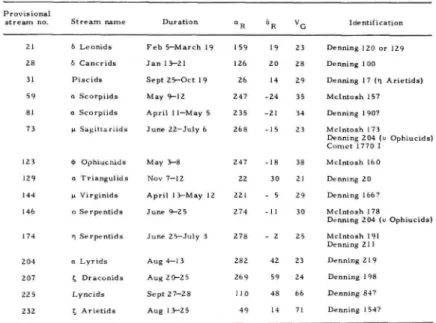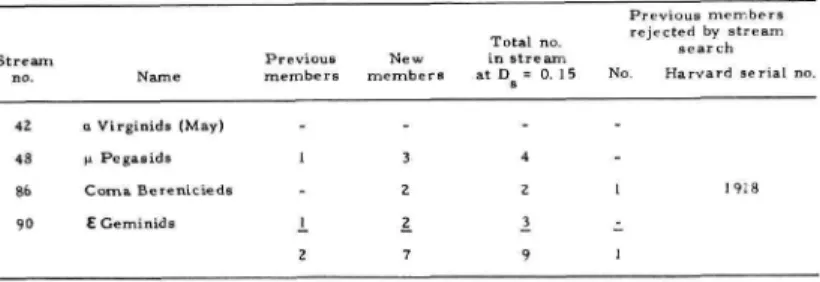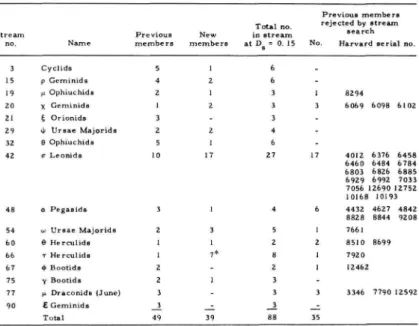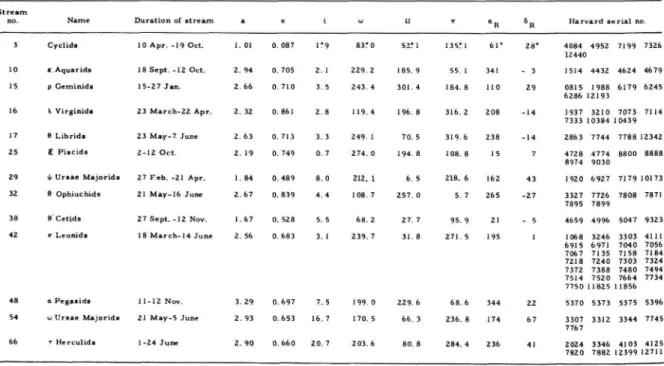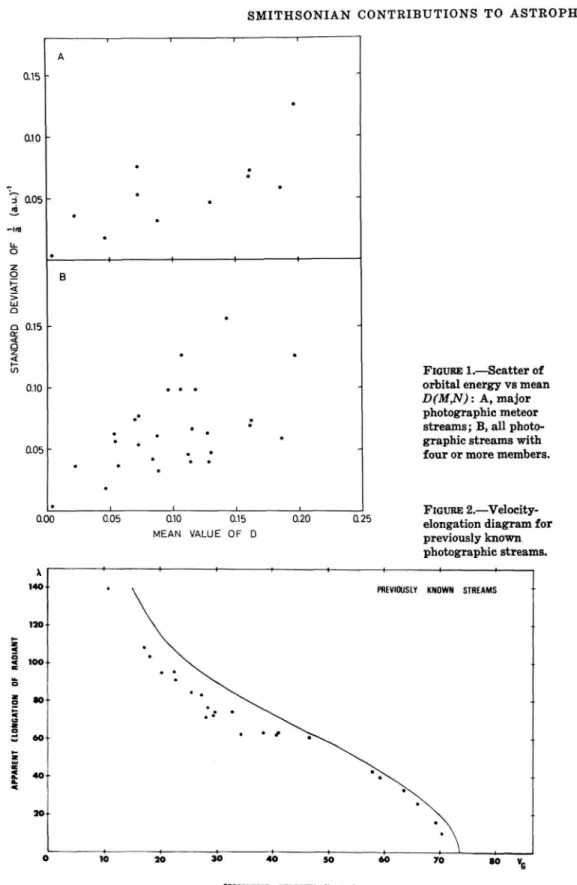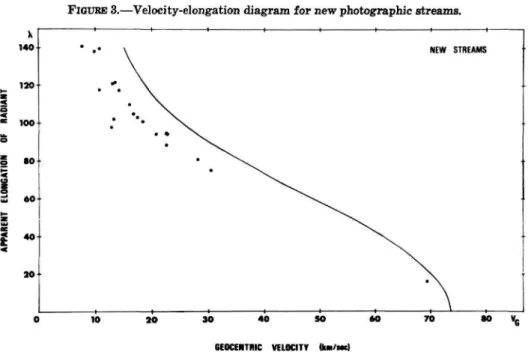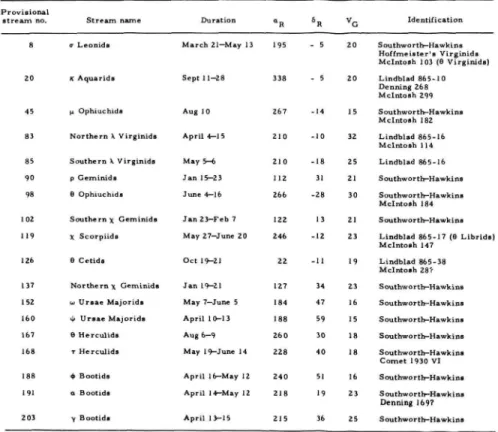Another series, Annals of the Astrophysical Observatory, was started in 1900 by the observatory's first director, Samuel P. The advantage of using orbital elements is that these parameters are more fundamental to the initial flux formation. As before, the current can be defined by comparing the orbital elements of the individual member N with the corresponding elements of the mean orbit M.
To overcome this difficulty, the numerical value of Ds must be adjusted to the size of the sample under investigation. This paper extends the study to 865 precise two-station photographic orbits from the Harvard Meteor Program. STREAMS. Once a computer stream search procedure has been set up, the rejection level remains to be determined, i.e. the numerical value of Ds to be used in the search.
In order not to influence our choice, we decided to perform independent stream searches at different Ds levels. The 865 sets of orbital elements were therefore tested for stream membership at rejection levels D and 0.10. The identification and discussion of these new flows is the subject of the remainder of this report. Three of the small showers found by McCrosky and Posen also appear as separate showers in our data.
Thus, of the seven moods found by McCrosky and Posen, four also appear in our smaller data sample. In one case (eg Pegasids) all four members of the stream were observed on two consecutive nights in the same year. Of the 24 possible new streams found by Southworth and Hawkins, 16 appear as separate streams in our search.
Of these smaller streams, 6 of the former and 3 of the latter were also detected in this survey. The table includes the revised orbital elements of the eight plumes detected by Southworth and Hawkins and verified by the current search, as well as five additional plumes discovered by us. When calculating the mean orbital elements for such a current (Table 6), negative inclinations are introduced for one group, and fl and o) are changed by 180°.
During current propagation, the orbital energy of the different individual current members will change. Inspection of Figure 2 will reveal that there are relatively few reference points in the lower right portion of the diagram. It is clear from considerations of the geometry involved that members of the meteor streams plotted at the upper left of the diagrams move in direct, low-inclination paths.
A comparison of Figures 3 and 4 clearly shows that the new streams found by both classification principles tend to cluster together in the upper left part of the velocity extension diagram.
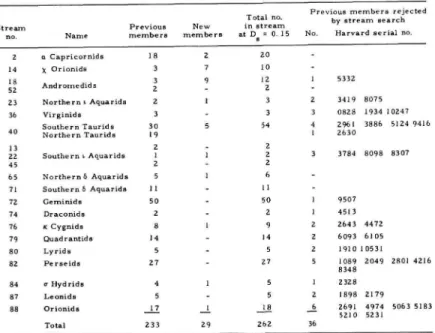
15 found seven new minor photographic streams
The lower current contribution found here is probably due to the larger errors in the orbital elements. The average orbital elements do not differ significantly from those published in other lists of meteor orbits determined by the Harvard Meteor Program (McCrosky and Posen, 1959; Jacchia, 1963). It follows that orbital data obtained by the graphical reduction procedure of McCrosky and Posen are sufficiently accurate for use in a computer stream search.
It should be noted that the mean radiative and geocentric velocities given by the computer program are obtained directly from the mean path of the flow. These quantities may therefore differ slightly from those obtained by averaging individual meteor data. It will be seen that the southern ones in Aquarids and a Capricorn are divided into a July and an August stream.
This division is clearly an erroneous result caused by large errors in the graphic scaling process. The Piscid Stream (No. 92) is included in Tables la and lb, as this stream was originally thought to have been associated with the Andromedas. The Andromedid current has recently been shown to be much more extensive than previously believed (Hawkins, Southworth and Stienon, 1959); however, the fairly high geocentric velocity and the early date of the appearance of stream 92 exclude the possibility of a connection with the Andromedas.
This phenomenon was previously detected in the Harvard data for the Taurids, t Aquarids and 8 Aquarids. In the case of the Virginid Stream, the accuracy of the track data is not sufficient to decide whether the observed separation into two branches is significant. However, only two members of the southern branch are present in the McCrosky and Posen sample, and the computer search included them in the northern branch.
Of their 47 new meteor associations, Jacchia and Whipple (1961) mention 4 more cases of a northern and a southern current component. Identification Southworth-Hawkins Hoffmeister's Virginids Mclntosh 103 (6 Virginids) Lindblad 865-10 Denning 268 Mclntosh 299 Southworth-Hawkins Mclntosh 182 Lindblad 865-16 Mclntosh 114 Lindblad 865-16 Southworth-Hawkins Southworth-Hawkins Mclntosh 184 Southworth-H awkins Lindblad 865- 17 (6 librides) Mclntosh 147. Southworth-Hawkins Southworth-Hawkins Southworth-Hawkins Southworth-Hawkins Southworth-Hawkins Comet 1930 VI Southworth-Hawkins Southworth-Hawkins Denning 169.
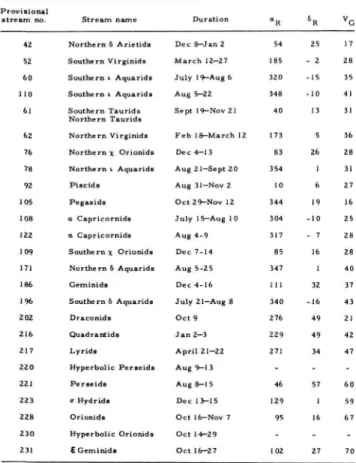
19 Terent'eva (1965, 1968), several more cases are
However, to simplify identification, most of the preliminary stream names used in previous articles have been retained in Tables 2a and 2b. However, the existence of two A-Virginid branches is somewhat open to doubt due to the large differences in g and a. The southern branch of the x Scorpiids was identified with the visual w2-Scorpiid shower (Mclntosh no. 146), the northern branch, with the visual x-Scorpiid shower (Mclntosh no. 147).
Although the computer search did not distinguish between the two components, a look at the perihelion argument of the individual terms showed that the current is composite, with one northern and one southern arm. NEW PHOTO CURRENTS.—After the identification of the well-confirmed photo-currents (Tables 1 and 2), a large number of previously unknown currents remain to be studied. Our /i-Sagittarid photocurrent is identical to the large shower of the same name cited by Mclntosh (1935).
An alternative interpretation of the two a-Scorpiid streams is to regard them as southern branches of the 0-Ophiuchid stream (No. 123). Similarly, o Serpentids can be interpreted as a northern branch of the 6 ophiuchids (no. 98). In view of the uncertainties associated with this method, the deviations in q and a must be considered insignificant.
Our Northern i-Aquarid current is probably a September appearance of Piscids, while our Piscid current 31 prob-. Hasegawa (1958) has published a general index of the expected theoretical radiation points for meteors associated with comets. Two members of the December Monocerotid stream are present in the McCrosky-Posen meteor sample (meteors 6040 and 9557).
A comparison of the average Monocerotid orbit with Comet 1917 I (Mellish) indicates close agreement in all orbital elements, and this correlation must now be considered reasonably certain. Our identification of the Monocerotids with Comet 1917 I receives support from the tentative link suggested by Whipple (1954) between this comet and the Harvard meteors 2313 and 2405. The detection of /i-Sagittariid, T-Herculid and Monocerotid photographic meteor streams add three more comet-meteor associations to Porter's 1952 list, leaving only one comet (1743 I) with no observed meteors.
A general catalog of the radiant points of meteor showers and fireballs and shooting stars observed at more than one station. Several streams are divided into northern and southern arms, and their orbital planes are symmetrical about the ecliptic plane.
